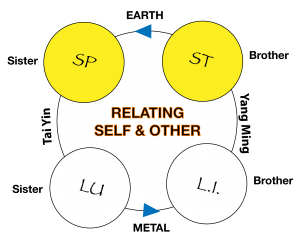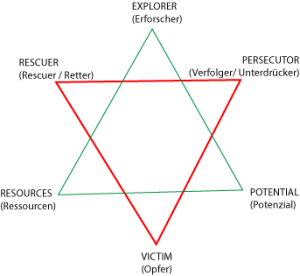The Six Forms of Touch is a system of training that I developed almost 40 years ago. The main idea is that the WAY in which you contact a person is as important, or even more important, than the meridians with which you choose to work. This article describes two of these Forms.
THE SIX DIVISIONS
Each form of touch relates to one of the Six Divisions, which I wrote about some time ago, and it might help to remember the deep meaning of these channels. Each of the six divisions is the combination of a leg meridian with an arm meridian and I think they were the inspiration for Masunaga’s meridian extensions.
However, the six divisions express deeper archetypes than the functions of the individual meridians. The Ling Shu states “The arms reach to Heaven while the legs stand on the Earth”. So each arm meridian embodies an energy through which our body expresses mental and spiritual capacities. In contrast the leg meridians express the way in which our feelings, thoughts and spirit can become embodied, supported by the Earth and transformed into action. The combined channel forms a bridge between the body and spirit and this bridge is a kind of combination of the energies of the leg and arm meridian. Just as the Five Elements combine the meridians into Yin-Yang pairs, as if they were brother and sister, the divisions combine them into Yang-Yang and Yin-Yin pairs, two brothers and two sisters.
For instance, the Stomach and the Large Intestine together form the Yang Ming division. The stomach function, essentially, is to reach out and ask for what we need. Notice that it is a Yang function so it impels our body into action – in this case to reach out and to take in nourishment. The Yin “sister” of the Stomach is the Spleen whose function is to receive the nourishment, filling and toning the flesh. The Stomach’s Yang “brother”, on the other hand, is the Large Intestine who gets rid of those things that we have taken in which are not needed.
So the Yang Ming has the deeper function of maintaining our boundaries and forming our individuality. The Large Intestine’s ability to say “No” to things which we don’t need is often a necessary precursor before we feel safe enough to ask for something that we do need. The Yang Ming mediates our exchange with the outer world and gives us our sense of self and other.
The last member of this family is the Lung, who is the sister to the Large Intestine and elder sister of the Spleen. The Lung’s relationship to the Large Intestine is that she expands us to fill our personal space the boundaries of which the Large Intestine guards. This expansive energy is also protective and allows us to have clear boundaries without them becoming barriers to contact. The Lung’s relationship to the Spleen is that she continues the inner expansion of the Spleen into the outer world.
Together they make a family which has the profound but simple function of maintaining our sense of self within our exchanges with the outer world.

FORMS OF TOUCH
Although the forms of touch are related to the Six Divisions, they are not treatment techniques. By this I mean that they are not techniques to be used when there is an imbalance in one division. Instead they describe six different dimensions of therapeutic contact and a good therapist will be using all of them. However, if there is an imbalance in one division, then one should be clear that your contact with the client includes the form of touch associated with it.
To illustrate this, let us start by describing the form associated with the YangMing division. The YangMing has the function of actively reaching for what we need and pushing out what we don’t need. The important aspect of this division is that it is active, so in order to support its energy the client has to be active and interactive.
This is unusual within the traditional format of a Shiatsu session because, usually, Shiatsu is performed in silence – the client being quite passive and the practitioner making the decisions about what the client needs. This silence also has an important function so I am not disparaging it. But a client who has difficulty with boundaries will often accept without question what someone else thinks they need and is therefore open to abuse in their lives. If we simply follow the routine of diagnosis and silent treatment within the Shiatsu session then we are not helping such a client to develop their active ability to maintain their boundaries.
In fact, I think this is true for many people, who need to have explicit permission to ask for what they need and to say no to things that feel wrong. This is what a strong YangMing gives us. The YangMing form of touch gives this permission and actively helps develop its energy in the client.
All the forms of touch have two aspects:
- A technique which develops a capacity or develops the client’s awareness.
- An inner attitude on the part of the practitioner. Our touch subtly transmits our inner state even if the client is not consciously aware of it.
The technique part of YangMing Touch is best performed as an ‘awareness exercise’. I help the client to scan through their own body and to notice any places which they feel are significant. This can be difficult for people who are not very aware of their body and I find that at first they only notice places where they feel pain or tension. However, as they receive more bodywork, more subtle sensations come to the surface. I then ask them if there is a place where they would like to be touched and if they are not sure, I just ask them to choose one of the places they noticed in the scanning.
When a person is actually touched, they can usually feel more clearly where they want the contact. It’s as if the mind has an idea what the body wants but, when the body is touched, it knows what it needs much more precisely than the mind does. So I immediately give them permission to change their request and to guide me to a place that feels ‘right’. I also say that they can ask me to change the quality of touch, for instance to press more deeply or to give soft contact with the palm. By this I’m giving them permission to say no to what I suggest and to ask for exactly what they need. This process is teaching them to listen to what their body wants rather than to what their mind THINKS their body wants.
The ‘inner attitude’ part of this form of touch requires the practitioner to let go of the desire to fix a problem, to let go of the high status which comes with the ability to diagnose and treat and to be totally open to the requests and corrections of the client. If you are used to deciding where to touch and how to touch it can feel disconcerting, even insulting, to be asked to do something different. Maybe you DO know best but the point is to teach the person to listen to their body and to develop their own expertise. To do that, you must get out of the way and let the other person explore themselves.
It can actually be a great liberation to form a more equal relationship with the client because, face it, there are times when you feel a bit lost and being able to ask the client where they would like to go next keeps contact with them and maintains the flow of the treatment. Moreover, this exercise gives them permission to give useful feedback while you are working.
In summary, YangMing touch is the aspect of therapeutic relationship which is helping a person to listen to their own needs and explore themselves rather than being dependent on the expertise of the therapist. It does not subtract from the competence of the therapist, in fact it needs awareness and skill to create an environment where the client is able to share what they really need and safe enough to guide the therapist while they are working.
TAI YIN TOUCH
The Yin side of this family of meridians is the TaiYin. It is the combination of Spleen and Lung. As I said before, the connection between these two energy functions is that they are both related to expansion. The Spleen is the ability of the organism to receive nourishment and fill the tissues, toning the organs and the flesh.The Lung takes that expansion further and fills our personal space, making contact with the outer world. Whereas the YangMing governs the gates of our personal space, the TaiYin fills it.
If the TaiYin is not working then there is a tendency to collapse inward and this movement sucks other people in to fill the hole. So it creates a Victim state which feels that it needs Rescue. Stephen Karpman described what he called the ‘Drama Triangle’, which describes how the Victim role is also vulnerable to abuse. This abuse doesn’t have to be evil in intent – the Rescuer can easily cross over boundaries, giving specific advice or performing particular interventions which subtly make the client more dependent on the Rescuer rather than empowering them to be more independent.

The essence of TaiYin touch is that it focuses on meeting someone at their boundary rather than diving in to fix their problems. I often call this form of touch “Front Door Touch” because, energetically, it is analogous to the act of knocking on someone’s door and waiting for them to open it, rather than marching into the house and sorting things out. This is a subtle attitude but makes an enormous difference to the relationship. It covers the way you ask questions, the way you physically touch and the clarity of the contracts you make. For example:
ASKING OPEN QUESTIONS
Open questions help a person to explore themselves and express their hidden feelings rather than simply supplying information to the questioner. This is particularly important in bodywork because open questions help the person to get in touch with their body instead of getting caught up in emotional stories. I call questions that narrow the field and ask for explanations “Pointed Questions”. In general pointed questions are asked for the understanding of the the practitioner, to help them make a diagnosis. Open questions, on the other hand, are asked for the benefit of the client. For instance:
Client: “Im feeling angry today”
Pointed Question: What happened to make you angry? (This takes the client away from the present, away from their body and into the past. Energetically this is an inward direction and doesn’t help the client to express their present feelings. It enmeshes them in a story)
Open Questions: Where do you feel that in your body? If you were to express that feeling with a movement, what would you do? Etc.
With open questions you are not trying to analyse or diagnose or fix things, but they stimulate the client to explore and express. In other words, energetically, they stimulate expansion and so activate the TaiYin.
TOUCHING THE SUPERFICIAL FASCIA
When one stretches a muscle there is a point of “first contact” where you have taken up the slack in the muscle fibres but have not begun to lengthen them. If you stay at that point then the receiver has the opportunity to let go, open up and lengthen the muscle themselves instead of being passively stretched, This is again analogous to knocking on the door and waiting for the owner to come to you.
In the same way, when one presses a tsubo, there is a point of first contact. This occurs when the touch has taken up the looseness in the skin and meets the elasticity of the layer of fascia just underneath it. This layer has only recently been recognised by anatomists for what it is. Previously it was just seen as subcutaneous fat, but actually it is a tough layer of loose knit connective tissue holding the fat cells. Moreover, it has recently been found that this layer also contains a large number of sensory nerves – mainly stretch receptors – which sense the movements of the muscles and organs below. It covers the whole body like an internal diving suit and, just as the skin is a sense organ facing outwards to sense the world through touch, this “superficial fascia” is a sense organ facing inwards, giving a sense of the holistic integrity of the body. In a sense it is the inner boundary of our body. Making contact with it but not going deeper gives the receiver a sense of their wholeness and knocks on their front door, encouraging their Qi to wake up and participate in the therapy.
In summary, Tai Yin touch comes forward to make contact but stops that forward energy immediately one senses that one is crossing a boundary. At that point, you don’t back off but open out, waiting for the receiver’s energy to expand outwards to meet you and open the door. It needs practice to reliably feel those boundaries because the Victim archetype is actually asking you to come in further. Using the Front Door analogy, the Victim is calling from the bedroom for you to open the door and come up to rescue them. If you don’t collude with this, you help the person to really express their underlying vulnerability and this, paradoxically empowers them to find their own resources rather than rely on rescue.
CONCLUSION
I hope that the descriptions of Yangming and Taiyin touch have given a clear idea of what I mean by a Form of Touch. I see these ‘therapeutic attitudes’ to be more effective than any particular choice of meridian that one may make. In fact, the wrong attitude can completely sabotage the therapy even if the diagnosis is precise and appropriate. For instance, if the receiver is low in energy, depressed, collapsed and with low tone to the muscles a TCM diagnosis may well indicate treatment of the Spleen meridian. But if the attitude of the therapist is that of an expert treating a passive client then the work will not wake up the Spleen function. In fact, it will maintain the dynamic, because the low Spleen energy is expressed in the archetype of the Victim and this is simply amplified by therapeutic Rescue. It is the attitudes of the Forms of Touch associated with the TaiYin (and maybe also of the YangMing later on) which activate and energise the self-supporting, expansive energy of the Spleen. Thus the Six Forms of Touch show what attitude and what quality of physical touch activate the holistic energy functions and make the whole therapy consistent with the work on the meridians.
 Bill Palmer was one of the pioneers of oriental bodywork and Qigong in Europe in the seventies. He recognized that the basis of oriëntale approach was to “facilitate inner communication”. He began to study how people could access oppressed parts of their personality through their body and through movement. He worked for ten years with teachers within the voice work of Alfred Wolfson and Roy Hart tradition. He studied Qigong, Chinese Herbal Medicine, Developmental Movement Therapy and Drama Therapy. He is the director of the School of Experiential Education, a school for learning through exploration and improvisation. Bill is the initiator of the shiatsu-style “Movement Shiatsu”. He teaches Movement Shiatsu around the world. He is also regularly involved in music improvisation.
Bill Palmer was one of the pioneers of oriental bodywork and Qigong in Europe in the seventies. He recognized that the basis of oriëntale approach was to “facilitate inner communication”. He began to study how people could access oppressed parts of their personality through their body and through movement. He worked for ten years with teachers within the voice work of Alfred Wolfson and Roy Hart tradition. He studied Qigong, Chinese Herbal Medicine, Developmental Movement Therapy and Drama Therapy. He is the director of the School of Experiential Education, a school for learning through exploration and improvisation. Bill is the initiator of the shiatsu-style “Movement Shiatsu”. He teaches Movement Shiatsu around the world. He is also regularly involved in music improvisation.
Bill Palmer and his wife Teresa Hadland are teaching in Wageningen a three day workshop 26, 27 and 28 of May 2023. Read more: https://handsontao.nl/bill-palmer/

Wat een mooi en helder artikel.
Ja he! Hij is echt gaaf. Kom je ook?